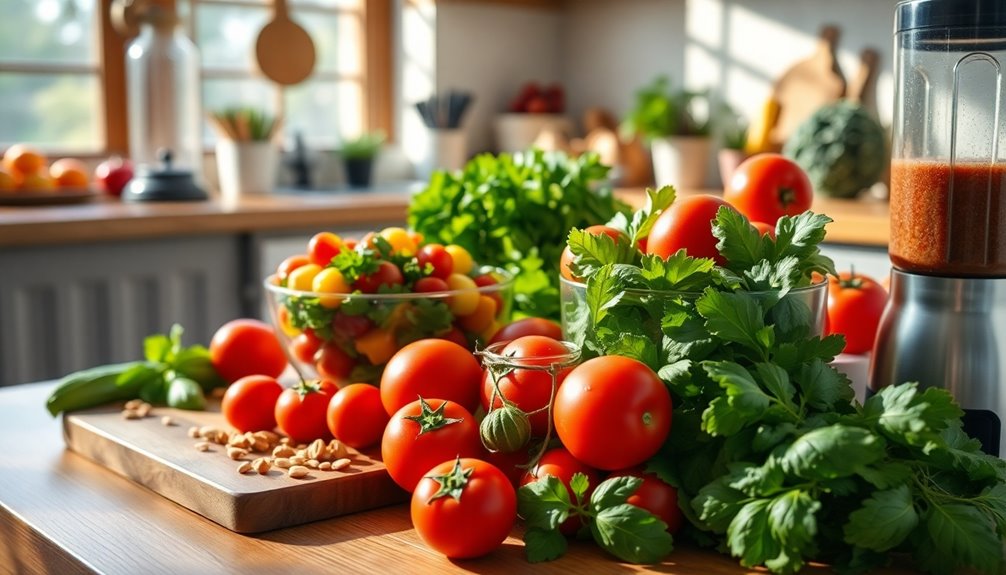To follow new healthy eating guidelines, start by understanding portion sizes. Measure your food to avoid overeating and listen to your hunger cues for mindful eating. Next, incorporate whole foods into your meals—think fruits, veggies, whole grains, and legumes, as they're packed with nutrients. Finally, plan your meals ahead of time. Create a weekly menu and stick to a grocery list to prevent impulse buys. Preparing ingredients in advance can make meal assembly a breeze. These simple steps can make a big difference. Stick around to discover more tips that can enhance your healthy eating journey!
Key Takeaways
- Understand Portion Sizes: Use measuring cups and food scales to accurately assess portion sizes for better control over your diet.
- Incorporate Whole Foods: Focus on consuming colorful fruits, vegetables, whole grains, legumes, and nuts for enhanced nutrition and health benefits.
- Plan Your Meals: Create a weekly menu and grocery list to organize meals, prevent unhealthy choices, and reduce food waste.
- Practice Mindful Eating: Eat slowly and savor your meals to recognize fullness cues and enhance your overall enjoyment of food.
- Utilize Smart Kitchen Tools: Invest in measuring tools and organizers to facilitate healthy cooking and maintain a tidy kitchen environment.
Understand Portion Sizes

Understanding portion sizes is crucial for maintaining a healthy diet. When you know what a proper serving looks like, you're less likely to overeat or underestimate your calorie intake. Start by familiarizing yourself with standard serving sizes for various food groups. For example, a serving of cooked pasta is about one cup, while a serving of meat should be roughly the size of your palm.
Using measuring cups or a food scale can help you accurately gauge your portions, especially when you're just starting out. It might feel tedious at first, but this practice gives you a clearer picture of what you're consuming. As you become more comfortable with portion sizes, you'll develop an intuitive sense of how much food you need. Additionally, investing in smart tool organizers can help you maintain a tidy kitchen space that promotes healthy cooking habits.
Pay attention to your hunger cues as well. Eating slowly and savoring your meals allows you to recognize when you're satisfied, preventing you from eating more than necessary. Additionally, learning about essential gardening tools can encourage a more active lifestyle, which complements your healthy eating habits.
Incorporate Whole Foods
Incorporating whole foods into your diet can significantly enhance your overall health. Whole foods, like fruits, vegetables, whole grains, legumes, nuts, and seeds, are packed with nutrients your body craves. These foods are less processed, meaning they typically contain fewer additives and preservatives, making them a healthier choice for you.
Start by filling your plate with colorful fruits and vegetables. They're not just visually appealing; they offer a variety of vitamins, minerals, and antioxidants that can boost your immune system. Additionally, incorporating organic mulching materials, like straw mulch, can improve the quality of your homegrown produce, which in turn enhances your intake of these vital nutrients.
Opt for whole grains instead of refined grains. Brown rice, quinoa, and whole-wheat bread provide more fiber, helping you feel full longer and supporting digestive health.
Don't forget about legumes! Beans and lentils are excellent sources of protein and fiber, making them a great addition to your meals.
Nuts and seeds are also fantastic snack options; they're nutrient-dense and can keep hunger at bay. Additionally, using quality plant food can further enhance the nutrient content of your meals by supporting the growth of your homegrown produce.
Plan Your Meals Ahead

Planning your meals ahead is a smart strategy that can make healthy eating much easier. By taking a little time to organize your meals, you'll save yourself from last-minute unhealthy choices and reduce food waste. Additionally, incorporating essential fertilizer spreaders into your gardening routine can help you grow fresh produce to include in your meals.
Here are four steps to help you get started:
- Create a Weekly Menu: Sit down once a week and plan your meals. Consider breakfast, lunch, dinner, and snacks. This gives you a clear vision of what you'll eat each day.
- Make a Grocery List: Based on your menu, write a grocery list to ensure you have all the ingredients you need. Stick to the list while shopping to avoid impulse buys.
- Prep Ingredients: Spend some time prepping ingredients at the beginning of the week. Wash and chop veggies, cook grains, or marinate proteins. This makes meal assembly quick and easy during busy days.
- Stay Flexible: Life happens, and plans might change. Keep some easy-to-make meals or leftovers on hand for those unexpected days when you need a backup.
Frequently Asked Questions
How Can I Stay Motivated to Eat Healthy Consistently?
To stay motivated eating healthy, focus on your goals and celebrate small victories. Surround yourself with supportive friends, experiment with new recipes, and remind yourself how great you feel when you nourish your body well.
What Are Some Quick Healthy Snack Ideas?
When hunger strikes like a thief in the night, quick healthy snacks can save the day. Try apple slices with almond butter, Greek yogurt with berries, or carrot sticks with hummus for delicious, nutritious options.
Are There Affordable Options for Healthy Eating?
Absolutely, you can find affordable options for healthy eating. Look for local produce, buy in bulk, and choose seasonal fruits and vegetables. Meal prepping also saves money while ensuring you eat nutritious foods throughout the week.
How Do I Read Food Labels Effectively?
To decode food labels like a pro, start with serving sizes, then check calories and nutrients. Look for added sugars and unhealthy fats. It's all about making informed choices that align with your health goals.
Can I Still Enjoy Dining Out While Eating Healthy?
Yes, you can still enjoy dining out while eating healthy! Look for grilled options, request dressings on the side, and share dishes. It's all about making mindful choices without sacrificing flavor and enjoyment.
Conclusion
By embracing these healthy eating guidelines, you're not just changing your plate; you're transforming your life. Think of portion sizes as the brush strokes in the masterpiece of your health, and let whole foods be the vibrant colors that bring it to life. Planning your meals is like charting a course through uncharted waters, ensuring you sail smoothly toward your wellness goals. So, take the helm, and watch your health flourish like a garden in full bloom!




